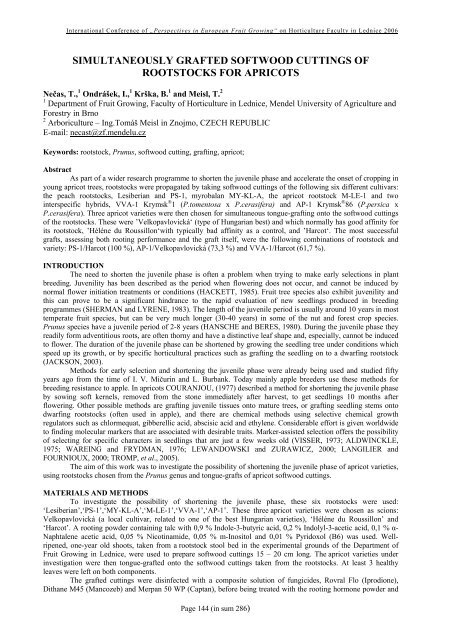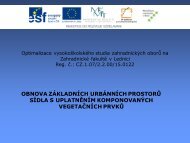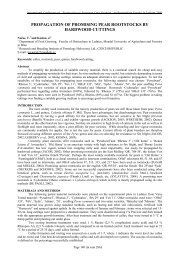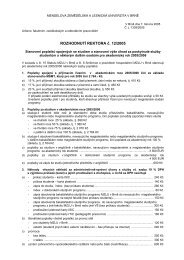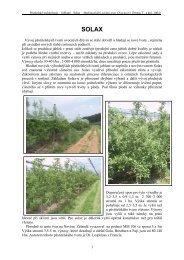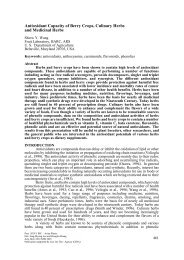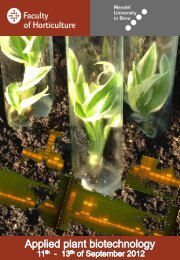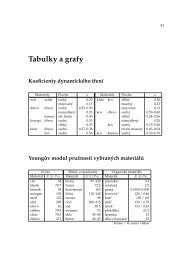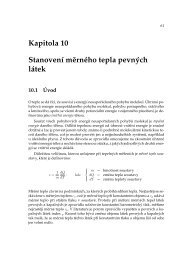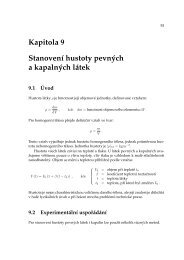simultaneously grafted softwood cuttings of rootstocks for apricots
simultaneously grafted softwood cuttings of rootstocks for apricots
simultaneously grafted softwood cuttings of rootstocks for apricots
Create successful ePaper yourself
Turn your PDF publications into a flip-book with our unique Google optimized e-Paper software.
International Conference <strong>of</strong> „Perspectives in European Fruit Growing“ on Horticulture Faculty in Lednice 2006SIMULTANEOUSLY GRAFTED SOFTWOOD CUTTINGS OFROOTSTOCKS FOR APRICOTSNečas, T., 1 Ondrášek, I., 1 Krška, B. 1 and Meisl, T. 21 Department <strong>of</strong> Fruit Growing, Faculty <strong>of</strong> Horticulture in Lednice, Mendel University <strong>of</strong> Agriculture andForestry in Brno2 Arboriculture – Ing.Tomáš Meisl in Znojmo, CZECH REPUBLICE-mail: necast@zf.mendelu.czKeywords: rootstock, Prunus, <strong>s<strong>of</strong>twood</strong> cutting, grafting, apricot;AbstractAs part <strong>of</strong> a wider research programme to shorten the juvenile phase and accelerate the onset <strong>of</strong> cropping inyoung apricot trees, <strong>rootstocks</strong> were propagated by taking <strong>s<strong>of</strong>twood</strong> <strong>cuttings</strong> <strong>of</strong> the following six different cultivars:the peach <strong>rootstocks</strong>, Lesiberian and PS-1, myrobalan MY-KL-A, the apricot rootstock M-LE-1 and twointerspecific hybrids, VVA-1 Krymsk ® 1 (P.tomentosa x P.cerasifera) and AP-1 Krymsk ® 86 (P.persica xP.cerasifera). Three apricot varieties were then chosen <strong>for</strong> simultaneous tongue-grafting onto the <strong>s<strong>of</strong>twood</strong> <strong>cuttings</strong><strong>of</strong> the <strong>rootstocks</strong>. These were ’Velkopavlovická‘ (type <strong>of</strong> Hungarian best) and which normally has good affinity <strong>for</strong>its rootstock, ’Héléne du Roussillon‘with typically bad affinity as a control, and ’Harcot‘. The most successfulgrafts, assessing both rooting per<strong>for</strong>mance and the graft itself, were the following combinations <strong>of</strong> rootstock andvariety: PS-1/Harcot (100 %), AP-1/Velkopavlovická (73,3 %) and VVA-1/Harcot (61,7 %).INTRODUCTIONThe need to shorten the juvenile phase is <strong>of</strong>ten a problem when trying to make early selections in plantbreeding. Juvenility has been described as the period when flowering does not occur, and cannot be induced bynormal flower initiation treatments or conditions (HACKETT, 1985). Fruit tree species also exhibit juvenility andthis can prove to be a significant hindrance to the rapid evaluation <strong>of</strong> new seedlings produced in breedingprogrammes (SHERMAN and LYRENE, 1983). The length <strong>of</strong> the juvenile period is usually around 10 years in mosttemperate fruit species, but can be very much longer (30-40 years) in some <strong>of</strong> the nut and <strong>for</strong>est crop species.Prunus species have a juvenile period <strong>of</strong> 2-8 years (HANSCHE and BERES, 1980). During the juvenile phase theyreadily <strong>for</strong>m adventitious roots, are <strong>of</strong>ten thorny and have a distinctive leaf shape and, especially, cannot be inducedto flower. The duration <strong>of</strong> the juvenile phase can be shortened by growing the seedling tree under conditions whichspeed up its growth, or by specific horticultural practices such as grafting the seedling on to a dwarfing rootstock(JACKSON, 2003).Methods <strong>for</strong> early selection and shortening the juvenile phase were already being used and studied fiftyyears ago from the time <strong>of</strong> I. V. Mičurin and L. Burbank. Today mainly apple breeders use these methods <strong>for</strong>breeding resistance to apple. In <strong>apricots</strong> COURANJOU, (1977) described a method <strong>for</strong> shortening the juvenile phaseby sowing s<strong>of</strong>t kernels, removed from the stone immediately after harvest, to get seedlings 10 months afterflowering. Other possible methods are grafting juvenile tissues onto mature trees, or grafting seedling stems ontodwarfing <strong>rootstocks</strong> (<strong>of</strong>ten used in apple), and there are chemical methods using selective chemical growthregulators such as chlormequat, gibberellic acid, abscisic acid and ethylene. Considerable ef<strong>for</strong>t is given worldwideto finding molecular markers that are associated with desirable traits. Marker-assisted selection <strong>of</strong>fers the possibility<strong>of</strong> selecting <strong>for</strong> specific characters in seedlings that are just a few weeks old (VISSER, 1973; ALDWINCKLE,1975; WAREING and FRYDMAN, 1976; LEWANDOWSKI and ZURAWICZ, 2000; LANGILIER andFOURNIOUX, 2000; TROMP, et al., 2005).The aim <strong>of</strong> this work was to investigate the possibility <strong>of</strong> shortening the juvenile phase <strong>of</strong> apricot varieties,using <strong>rootstocks</strong> chosen from the Prunus genus and tongue-grafts <strong>of</strong> apricot <strong>s<strong>of</strong>twood</strong> <strong>cuttings</strong>.MATERIALS AND METHODSTo investigate the possibility <strong>of</strong> shortening the juvenile phase, these six <strong>rootstocks</strong> were used:‘Lesiberian’,‘PS-1’,‘MY-KL-A’,‘M-LE-1’,‘VVA-1’,‘AP-1’. These three apricot varieties were chosen as scions:Velkopavlovická (a local cultivar, related to one <strong>of</strong> the best Hungarian varieties), ‘Héléne du Roussillon’ and‘Harcot’. A rooting powder containing talc with 0,9 % Indole-3-butyric acid, 0,2 % Indolyl-3-acetic acid, 0,1 % α-Naphtalene acetic acid, 0,05 % Nicotinamide, 0,05 % m-Inositol and 0,01 % Pyridoxol (B6) was used. Wellripened,one-year old shoots, taken from a rootstock stool bed in the experimental grounds <strong>of</strong> the Department <strong>of</strong>Fruit Growing in Lednice, were used to prepare <strong>s<strong>of</strong>twood</strong> <strong>cuttings</strong> 15 – 20 cm long. The apricot varieties underinvestigation were then tongue-<strong>grafted</strong> onto the <strong>s<strong>of</strong>twood</strong> <strong>cuttings</strong> taken from the <strong>rootstocks</strong>. At least 3 healthyleaves were left on both components.The <strong>grafted</strong> <strong>cuttings</strong> were disinfected with a composite solution <strong>of</strong> fungicides, Rovral Flo (Iprodione),Dithane M45 (Mancozeb) and Merpan 50 WP (Captan), be<strong>for</strong>e being treated with the rooting hormone powder andPage 144 (in sum 286)
International Conference <strong>of</strong> „Perspectives in European Fruit Growing“ on Horticulture Faculty in Lednice 2006then put into plant pots with a mixture <strong>of</strong> peat and pure sand. The plant pots were placed in a shaded greenhousewith high humidity.The plants were subsequently assessed on the basis <strong>of</strong> which <strong>of</strong> the <strong>cuttings</strong> had successfully rooted andwhich <strong>of</strong> the scions were living i.e. had green buds and leaves.RESULTS AND DISCUSSIONThe highest percentage survival was seen in the combination PS-1/Harcot, at 100 % (Table 1), andthe variety Harcot also had the most vigorous growth. A commercially viable grafting success rate was seen in thecombinations VVA-1/Harcot (61.7 %) and AP-1/Velkopavlovická (73,3 %), while a marginal success rate was seenin the combination AP-1/Harcot (47 %). The worst results were <strong>for</strong> the combinations M-LE-1/Velkopavlovická, PS-1/Velkopavlovická and PS-1/Héléne du Roussillon.The most successful grafts were seen in the rootstock ´AP-1´ (44%), then ´PS-1´ (39 %) and ´VVA-1´ (34%). The variety with the highest grafting success rate was ´Harcot´ (48,6 %). Statistical analysis using the Student-Newman-Keuls test, s<strong>of</strong>tware Unistat 5.1, found significant differences between the combinations <strong>of</strong> <strong>rootstocks</strong> andvarieties, and between the varieties. No statistically significant differences were found between the rooting abilities<strong>of</strong> the <strong>rootstocks</strong>.An interesting result was the relatively low survival rate <strong>for</strong> scions <strong>of</strong> the variety ´Velkopavlovická´,especially in combination with the apricot seedling ´M-LE-1´. It is also interesting that the combination <strong>of</strong> ´Harcot´on peach rootstock PS-1 had considerably the highest survival percentage. According to KOLESNIKOV, (1964), itis difficult to successfully make grafts between different species <strong>of</strong> fruit, such as peach and almond or peach andapricot, and some varieties <strong>of</strong> pear and quince, which tend to break at the point <strong>of</strong> the graft even though callus<strong>for</strong>mation is good. The best results are always achieved by grafts between members <strong>of</strong> the same species.In addition to the poor affinity <strong>of</strong> <strong>rootstocks</strong> and scions, another problem <strong>of</strong> this particular method <strong>of</strong>propagation could be the growing environment itself. Cold and rainy weather, with low light levels, could negativelyaffect rooting in years such as 2006. BILLING, (1990) described suitable air temperatures in the rootingenvironment as ranging from 20° to 25 °C, and although bottom heating to 20 °C is not strictly necessary it mayimprove the rooting <strong>of</strong> <strong>s<strong>of</strong>twood</strong> <strong>cuttings</strong>.Winter survival can be a problem when taking <strong>s<strong>of</strong>twood</strong> <strong>cuttings</strong> to propagate many difficult to root Prunusspecies and hybrids. These can take several months to root and are then very difficult to transplant and subsequentlyestablish (TROMP et al., 2005). The problems <strong>of</strong> overwintering <strong>grafted</strong> <strong>s<strong>of</strong>twood</strong> <strong>cuttings</strong> will have to beinvestigated in the next few years.WEBSTER, (1995) describes successful methods <strong>of</strong> shortening the juvenile phase by 1-2 years in appletrees (MM.106/Cooper 7SB2), plum trees (Myrobalan B/Burmosa plum) and pear trees (Quince A/ Conference,Williams, Bon Chretien). Grafted hardwood <strong>cuttings</strong> were taken in November using a portable Omega machine andplanted directly in the field or nursery. TETSUMURA et al., (2003) experimented with grafting <strong>s<strong>of</strong>twood</strong> andhardwood <strong>cuttings</strong> using persimmon, where the <strong>s<strong>of</strong>twood</strong> <strong>cuttings</strong> rooted better than the hardwood <strong>cuttings</strong> and the<strong>grafted</strong> <strong>cuttings</strong> rooted even better than the non-<strong>grafted</strong> <strong>cuttings</strong> (success rates ranged from 13 % to 33 %).CONCLUSIONThe experiment showed that the technique <strong>of</strong> <strong>simultaneously</strong> taking <strong>cuttings</strong> and making grafts is arelatively good method <strong>for</strong> shortening the juvenile phase in fruit trees. The most difficult part <strong>of</strong> the process isproviding the right growing conditions in the propagating greenhouse. The effect <strong>of</strong> rootstock on graft compatibiltyis not statistically significant. However, it is too early to say how useful this method will be compared to classicalmethods.AcknowledgmentsThis research was carried out with the support <strong>of</strong> grant number QF 3221 from the National Agency <strong>for</strong>Agricultural Research, Ministry <strong>of</strong> Agriculture, Czech Republic.REFERENCESAldwinckle, H. S., 1975. Flowering <strong>of</strong> apple seedlings 16-20 months after germination. HortScience 10: 124-126;Billing, H. O, 1990. Rapid production <strong>of</strong> apple <strong>rootstocks</strong> by <strong>s<strong>of</strong>twood</strong> cutings. Sci. Hort. 42: 277-287.Couranjou, J., 1977. Variétés d’abricotiers. Invuflec, Paris.Hackett, W. P. 1985. Juvenility, maturation and rejuvenation in woody plants. Hort. Rev 7: 103-155.Hansche, P. E., Beres, W., 1980. Genetic remodelling <strong>of</strong> fruit and nut trees to faciliate cultivar improvement.HortScience 15: 710-715.Jackson, J. E. 2003. Biology <strong>of</strong> apples and pears. Cambridge University Press: 73-77, ISBN 0521380189.Kolesnikov, V., 1964/2002. Fruit biology. University Press <strong>of</strong> the Pacific Honolulu, Hawai, ISBN 1-4102-0201-1.Langilier, P., Fournioux, J. C., 2000. Endogenous abscisic acid in juvenile and adult grape (Vitis vinifera L. Cv.Pinot noir). Vitis 39: 47-48.Lewandowski, M., Zurawicz, E., 2000. Shortening the juvenile period in apple seedlings by grafting on p22dwarfing rootstock. J Fruit Ornamental Res VIII (1): 33-37.Page 145 (in sum 286)
International Conference <strong>of</strong> „Perspectives in European Fruit Growing“ on Horticulture Faculty in Lednice 2006Sherman, W. B., Lyrene, P. N. 1983. Handling seedling populations. In: Methods in Fruit Breeding (Moore J.N.,Janick, J., eds) Purdue Univ. Press, West Lafayette, Indiana.Tetsumura, T., Tao, R., Sugiura, A., Fujii, Y. and Yoda, S. 2003. Cutting propagation <strong>of</strong> some dwarfing<strong>rootstocks</strong> <strong>for</strong> persimmons. Acta Hort. (ISHS) 601: 145-149.Tromp, J., Webster, A. D., Wertheim, S. J., 2005. Fundamentals <strong>of</strong> temperate zone tree fruit production.Backhuys Publishers, Leden: 89-92, ISBN 90-5782-152-4.Visser, T., 1973. The effect <strong>of</strong> <strong>rootstocks</strong> on growth and flowering <strong>of</strong> apple seedlings. J.Amer Soc Hort Sci 98: 26-28.Wareing, P. F., Frydman, V. M., 1976. General aspects <strong>of</strong> phase change with special reference to Hedera helix L.Acta Hort 56: 57-68.Webster, A. D., 1995. Temperate fruit tree rootstock propagation. New Zeland Journal <strong>of</strong> Crop and HorticulturalScience, Vol. 23: 355-372.Table 1. % success <strong>of</strong> <strong>grafted</strong> <strong>s<strong>of</strong>twood</strong> <strong>cuttings</strong>Rootstockssuccess <strong>of</strong> average <strong>of</strong>average <strong>of</strong> success(<strong>s<strong>of</strong>twood</strong> cultivars <strong>grafted</strong> plants (%) success in2005/2006in cultivarscutting)<strong>rootstocks</strong>Velkopavlovická 18.4 VelkopavlovickáVVA-1 Héléne du Roussillon 21.734%Harcot 61.7Harcot 46.724.0%AP-1 Héléne du Roussillon 13.344%Velkopavlovická 73.3Héléne du Roussillon 20.0 Héléne du RoussillonM-LE-1 Velkopavlovická 6.720%Harcot 33.3Héléne du Roussillon 30.020.3%Lesiberian Velkopavlovická 20.022%Harcot 16.7Harcot 33.4 HarcotMY-KL-A Velkopavlovická 18.426%Héléne du Roussillon 26.7Héléne du Roussillon 10.048.60%PS-1 Velkopavlovická 6.739%Harcot 100.0GF305Héléne du Roussillon 23.316.7Velkopavlovická 10.0Number <strong>of</strong> growing grafts onVVA-1 rootstockVelkopavlovická; 16,7%Number <strong>of</strong> growing grafts onAP-1 rootstockHarcot; 46,7 %Harcot; 83,3 %Héléne duRoussillon;23,3 %Velkopavlovická; 73,3 %Héléne duRoussillon;13,3 %Velkopavlovická; 6,7 %Number <strong>of</strong> growing grafts onPS-1 rootstockHéléne duRoussillon;13,3 %Number <strong>of</strong> growing grafts onMY-KL-A rootstockHéléne duRoussillon;10,0 %Harcot; 100 %Velkopavlovická; 10,0%Harcot; 26,7 %Page 146 (in sum 286)
International Conference <strong>of</strong> „Perspectives in European Fruit Growing“ on Horticulture Faculty in Lednice 2006Graph 1. % success <strong>of</strong> <strong>grafted</strong> <strong>s<strong>of</strong>twood</strong> <strong>cuttings</strong> in year 2006120,0100,080,0red colour is highly under economic importance10083,3%60,040,020,0203013,323,3 23,310 10 106,716,76,72033,326,716,70,0M-LE-1 / Héléne du RoussillonLesiberian / Héléne du RoussillonMY-KL-A / Héléne du RoussillonVVA-1 / Héléne du RoussillonGF305 / Héléne du RoussillonPS-1 / Héléne du RoussillonMY-KL-A / VelkopavlovickáGF305 / VelkopavlovickáPS-1 / VelkopavlovickáVVA-1 / VelkopavlovickáM-LE-1 / VelkopavlovickáLesiberian / VelkopavlovickáM-LE-1 / HarcotPS-1 / HarcotVVA-1 / HarcotMY-KL-A / HarcotLesiberian / HarcotGraph 2. % success <strong>of</strong> <strong>grafted</strong> <strong>s<strong>of</strong>twood</strong> <strong>cuttings</strong> in year 200580,070,060,0red colour is highly under economic importance73,3%50,040,030,020,046,740 40 4026,713,320 2010,00,0MY-KL-A / Héléne du RoussillonMY-KL-A / VelkopavlovickáMY-KL-A / HarcotAP-1 / HarcotAP-1 / Héléne du RoussillonAP-1 / VelkopavlovickáVVA-1 / HarcotVVA-1 / Héléne du RoussillonVVA-1 / VelkopavlovickáPage 147 (in sum 286)


